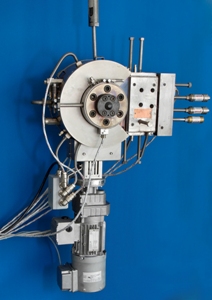Nov 5 2013
Nano additives can make plastics scratch and flame proof, or give them antibacterial properties. For this to work, the particle distribution within the plastic compound must be absolutely correct. A new device is now able to test the distribution in real time.
 onBOX uses a sensor system to test the composition of plastics enriched with nanoparticles. The unit is mounted directly onto the mixing plant, and is able to monitor particle distribution. © Fraunhofer ICT
onBOX uses a sensor system to test the composition of plastics enriched with nanoparticles. The unit is mounted directly onto the mixing plant, and is able to monitor particle distribution. © Fraunhofer ICT
We encounter functional plastics parts whenever we open the refrigerator door. Besides being easy to clean and ergonomically shaped, the material built into a refrigerator also have antibacterial properties, thanks to nano-sized additives mixed in with the pellets of plastic during the manufacturing process. Parts like these can be modified to have all sorts of different properties, which vary according to the type and shape of the particles of additive and their distribution within the polymer compound. Even though these particles are less than 100 nanometers across, it takes just a tiny quantity to make the plastic antibacterial, scratch proof and flame retardant, electrically or thermally conductive, or to give it greater mechanical rigidity. For these properties to function as intended, the ratio of pellets to additives and the overall particle distribution has to be exactly right. Until now, checking this has always been a very complicated and time-consuming process that had to be carried out after the material is made. Manufacturers are often only able to achieve the desired plastic formula after mixing several trial batches, which slows down the production process and wastes material.
The Fraunhofer Institute for Chemical Technology ICT in Pfinztal near Karlsruhe has been working with other partners to develop a tool for characterizing polymer nanocomposites during the ongoing production process itself. “This is not only more cost-effective in terms of material and time, it also helps us to improve the quality of the properties that the added nanoparticles bring to the polymer,” says Irma Mikonsaari of the ICT.
On-the-spot analysis directly at source
onBOX is simply mounted to the exit nozzle of the conveyor, where its sensors analyze and characterize the polymer compound while it is still in the mixing plant. The sensors use a combination of technologies including spectroscopy, ultrasound and microwaves to test the composition of the polymer-nanoparticle compound. They measure its viscosity, pressure and particle distribution, including any possible fluctuations in concentration, while simul- taneously measuring the compound’s temperature and its thermal and electrical conductivity. A computer then compares this data to the system’s command variables and processes it inside an artificial neural network. The computer determines the precise mixing ratios needed to achieve the intended effect as well as the manufacturing process this requires, and feeds this information directly to the machine’s control system. “The result is that the network of nanoparticles develops just as we want it to,” says Mikonsaari, “with optimal distribution of the individual particles.” She adds: “We are able to characterize the state of the polymer melt as it is being discharged through the nozzle.”
Mikonsaari will be presenting onBOX on November 19, 2013 at the NanoOnSpect workshop being held at the ICT in Pfinztal, where it will be attached to a pilot plant able to process 30 kilograms of polymer compound. ICT researchers will also be reporting on the current status of the EU-funded NanoOnSpect project. Those invited to attend include raw material suppliers, plastics manufacturers and companies that process and reuse smart plastics.
NanoOnSpect was launched in 2011 and will run for a total of four years. The consortium draws on the scientific community, associations and industrial partners and was set up with the aim of optimizing manufacturing processes for smart plastics that feature nanoparticle additives. Project partners are seeking to achieve this in two ways: on the one hand, they are developing technologies that help to improve characterization of the size, structure and distribution of the nanoparticle additives as well as the properties of the polymer compounds. On the other, they are designing a new mixing procedure that combines the advantages of existing processes. “onBOX is a very tangible product of our research from which industry stands to benefit immediately,” says Mikonsaari, pointing out the relevance of the new tool and its scope for practical application.